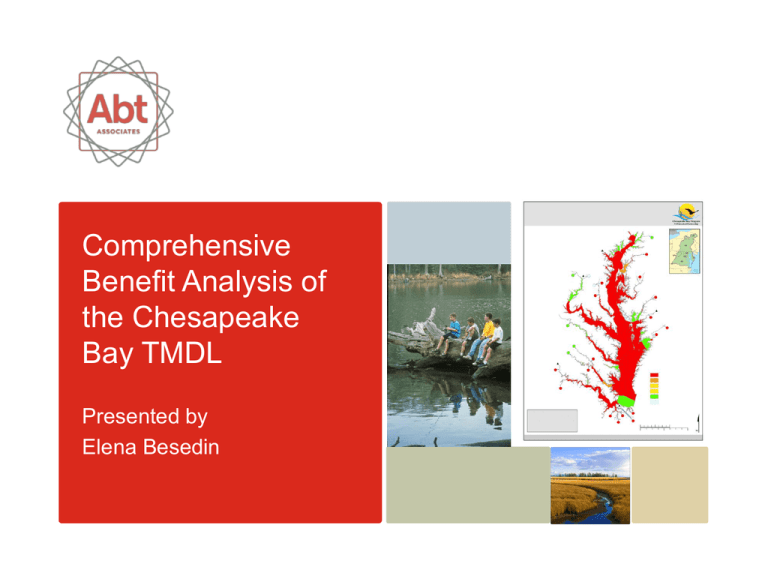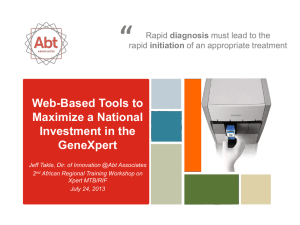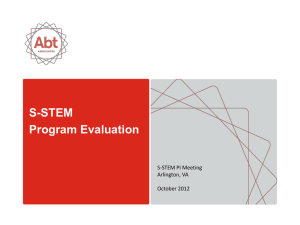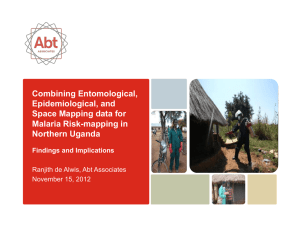Water Quality - Abt Associates
advertisement

Comprehensive Benefit Analysis of the Chesapeake Bay TMDL Presented by Elena Besedin Comprehensive Benefit Analysis of the Chesapeake Bay TMDL BMP Effects Direct Effects Nutrient load Sediment Load Indirect Effects Air pollutant release Vegetation/open space Hydrology Models Water Quality Aquatic Ecosystem Fisheries Model Models Vegetation effects on air Hydrological Models Flood risk models Human health risk Monetization approaches Abt Associates | pg 2 Benefits of the Chesapeake Bay TMDL: Previous Analyses Benefit categories included in previous analyses (M. Cropper and W. Isaac, 2011) – Commercial fishing – Water-based recreation (fishing, swimming, boating – Property values – Nonuse values Ancillary benefit categories (EPA/ORD) – Carbon sequestration – Air pollutant removal (screening level) Abt Associates | pg 3 Comprehensive Analysis of the Chesapeake Bay TMDL Including additional benefit categories – Modeling additional ecological effects and ecosystem services provided by Chesapeake Bay and BMPs to reduce nutrient loadings beyond those accounted for in previous analyses Modeling additional market effects Estimating potential employment effects Including additional services and other economic effects in benefit-cost analysis – Accounting for costs and benefits based on TMDL implementation timeline • Phased controls: 60% of actions by 2017; 100% by 2025 • Potential to evaluate costs and benefits over implementation timeline – Potential for optimization of BMPs accounting for additional ecosystem service benefits Abt Associates | pg 4 Direct TMDL Effects: Nutrient and Sediment Load Reductions Nutrient reductions impacts: Reduced Algal Blooms – Increased nutrient retention, benthic infauna, community composition, increased oxygen availability, increased water clarity and light transmission Increased Oxygen Availability – Direct effects on frequency of hypoxic events, macroinfaunal diversity and biomass, increased bivalve populations and filtration rates, nutrient cycling, fisheries productivity Decreased Acidification – Population and growth effects of major calcifiers, altered vital rates, community composition Nutrients Algae Turbidity O2 Light Benthic Production Redox Nitrification Uptake Suspension Nutrient Recycling Abt Associates | pg 5 Direct TMDL Effects: Nutrient and Sediment Load Reductions Sediment reductions improve many factors: Increased Water Clarity – Direct effects on benthic primary production, macroinfaunal diversity and biomass, shift in relative importance of demersal (increase) and pelagic (decrease) food webs Increased Submerged Aquatic Vegetation (SAV) Area – Positive feedback with particle trapping and sediment binding, reduced efflux of sediment nutrients, increased nutrient assimilation, increased oxygen production Nutrients Algae Turbidity O2 Light Benthic Production Redox Nitrification Uptake Suspension Nutrient Recycling Abt Associates | pg 6 Indirect TMDL Effects Example BMPs Non-Water Quality Effects Land Management – – – – Agricultural land retirement Tree planting Forest buffers Grass buffers – in open space / vegetated areas – in the number of trees – in riparian habitat / wetlands Agriculture – Erosion control (buffer zones) – Animal waste management Urban Stormwater Management – in impervious cover Hydrology – – – – Natural area restoration – Wetland restoration – Stream restoration Land in on-site water storage in groundwater recharge in flood risk stream channel protection Air effects – reduced ammonia releases – air pollutant removal by vegetation – in temperature extremes Abt Associates | pg 7 Identifying and Evaluating Ecosystem Services Ecosystem Service Category Water Quality Changes Ancillary BMP Services Provisioning • Habitat for fish/shellfish consumed by humans • Drinking water supply • Agricultural and industrial water supply • Navigation • Riparian/terrestrial habitat for fish and game consumed by humans • Provision of wood and other forest products • Drinking water supply (groundwater) Cultural Water-based Recreation • Swimming • Fishing • Hunting • Boating • Near water activities Aesthetic (water clarity/color) • Property values • Scenic vistas Nonuse • Habitat preserving aquatic biodiversity Land and Near Water Recreation • Fishing and shellfishing • Hunting (waterfowl and game) • Birding • Hiking/nature enjoyment Aesthetic (landscape effects) • Property values • Scenic vistas Education • Wetlands/forest education centers Nonuse • Habitat preserving wildlife and plant biodiversity Abt Associates | pg 8 Identifying and Evaluating Ecosystem Services (continued) Ecosystem Service Category Regulating Water Quality Changes • • • • • • Nutrient cycling Primary production Hypoxia events Ecosystem resilience pH Water Clarity Ancillary BMP Services Air • Air pollutant releases (ammonia) • Air pollutant removal by vegetation • Carbon storage • Reduction in air temperature volatility Soil • Erosion control • Sediment retention Hydrology • Flood control • Stream bank stabilization • Stream channel protection • Groundwater recharge Water Quality • Filtration/Nutrient removal (groundwater) • Reduction in stream temperature volatility Abt Associates | pg 9 Bringing the Pieces Together: Example Framework for Estimating TMDL Benefits Simplified representation showing only selected components of the analysis. Abt Associates | pg 10 Effects of Increased Vegetation: i-Tree Model, US Forestry Service i-Tree is a peer-reviewed model developed by the USFS – Estimates services from trees and shrubs – Use field data or GIS layers for tree canopy and impervious surface Air Pollution Removal (PM10, PM2.5, NO2, SO2, CO, O3) – Pollution removal per unit of tree canopy based on local conditions – Can be converted to changes in concentrations Carbon Sequestration and Storage – Sequestration and storage per unit of tree canopy Energy Savings – Shading and windbreak savings based on tree placement Can be supplemented with data for other vegetation types Abt Associates | pg 11 Human Health Effects from Reduced Air Pollution (Example) Population Distribution by Age and Presence of Sensitive Subgroups For each subgroup and baseline and postregulation: Pollutant exposure distribution Adverse health effects distribution $ Monetary Value of Health Effects BenMap (EPA_OAQPS) Abt Associates | pg 12 Flood Analysis Approach (Example) Updated HAZUS-HM Inventory in 2040 Channel/Floodplain assumptions in SWAT, Manning’s Equation SWAT Flows Flood Hazard (Flood Frequency Analysis) Flood Flows Channel/Floodplain assumptions in SWAT Flood Depth Estimation Flood Depths NFRST Flood Zone Estimation Floodplain Areas per Census Block Stream lines Census Block GIS Data Flood Impacts $ SWAT: Soil and Water Assessment Tool developed by USDA HAZUS-MH: Hazards U.S. Multi-Hazard (HAZUS-MH) Tool developed by FEMA NFRST: National Flood Risk Screening Tool developed by Abt Associates Abt Associates | pg 13 Market-based Approaches Water Quality – – – – – Commercial fish/shellfish harvest Drinking water treatment Reservoir dredging Navigational waterways dredging Agricultural/industrial water supply Air – Electricity savings – Technology alternatives to carbon sequestration – Technology alternatives to air pollutant removal Hydrological Benefits – Flood damages – Groundwater quantity – Drinking water treatment (groundwater) – Avoided cost of infrastructure maintenance and expansion – Avoided cost of stream restoration – Water storage for beneficial use Employment Effects Regional Economic Impacts – Input output models Abt Associates | pg 14 Nonmarket Valuation Water Quality Landscape Water-based recreation – – – Human health (e.g., exposure to pathogens in shellfish, drinking water or while swimming) – – – Cost of illness SP studies Averting behavior Aesthetic – – – Recreational demand models Stated preference (SP) studies Hedonic studies Hedonic property SP studies Recreational demand Nonuse values (aquatic life support, biodiversity, overall ecosystem health and resilience) – Land (including wetlands) – Land-based recreation • Recreational demand models • SP studies • Hedonic studies – Aesthetic • Hedonic property • SP studies • Recreational demand – Nonuse (wildlife habitat, biodiversity) • SP studies Stated preference studies Abt Associates | pg 15 Nonmarket valuation Air Hydrology Human health – Exposure to criteria pollutants (mortality and morbidity) – SP studies • Cost of illness • Stated preference studies (BT) – Exposure to extreme temperature (mortality) – Hedonic property models Carbon sequestration • Social Cost of Carbon (SCC) Groundwater protection – SP studies – Averting behavior • SP studies Flooding (value of reduced flood risk) Stream channel protection – SP studies – Hedonic property models Abt Associates | pg 16 Value of Ancillary Services from Urban BMPs for Chesapeake Bay Watershed EPA/ORD analysis, 2011 Abt Associates | pg 17 Example Cost-Effectiveness of BMPs with and without Ancillary Benefits Abt Associates | pg 18 Challenges, Gaps, Overlaps Quantification – Lack of data or models to estimate ecological improvements (e.g., ecosystem resilience, stream channel stabilization) – Some beneficial effects are omitted from the water quality modeling step (e.g., pathogens) – Timeline for TMDL implementation Monetization – Linking ecological and economic endpoints – Selecting ecological metrics that provide an accurate representation of ecosystem change – – Measurable Comprehensive Interpretable Applicable Potential overlapping and double counting of benefits Property value change vs. recreational benefits Property value change from improved landscape vs. water quality Capturing multi-media effects Selecting an optimal set of BMPs: cost-benefit optimization framework Abt Associates | pg 19








